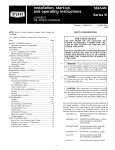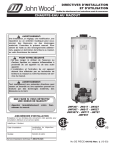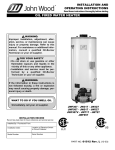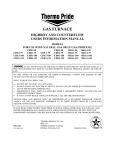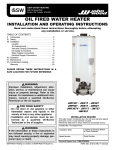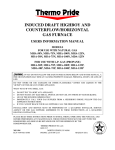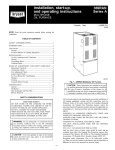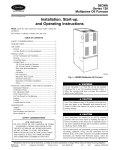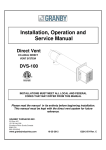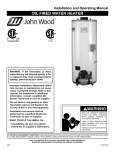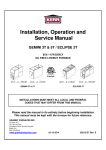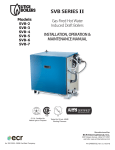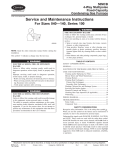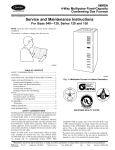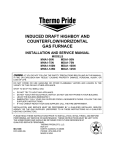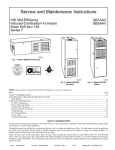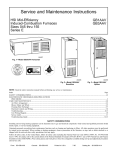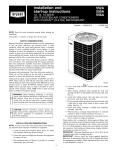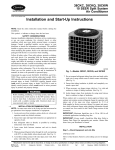Download Installation, Start-Up, and Operating Instructions
Transcript
58BMA 3-Way Multipoise Oil-Fired Furnace Visit www.carrier.com Installation, Start-Up, and Operating Instructions → For Sizes 075—155, Series 111 SAFETY CONSIDERATIONS NOTE: Read the entire instruction manual before starting the installation. This symbol → indicates a change since the last issue. FOR YOUR SAFETY INDEX Page SAFETY CONSIDERATIONS..................................................1-2 Minimum Clearance to Combustibles......................................2 INTRODUCTION ..........................................................................2 LOCATION ................................................................................2-4 Air for Combustion and Ventilation.....................................2-3 Duct Work Recommendations ..............................................3-4 VENTING INSTRUCTIONS.....................................................4-5 Pre-Installation Vent System Inspection ..................................4 Masonry Chimney .................................................................4-5 Factory-Built Chimneys............................................................5 Horizontal Venting....................................................................5 OIL BURNER ................................................................................5 OIL CONNECTIONS ....................................................................5 BAROMETRIC DRAFT CONTROL ...........................................5 ELECTRICAL................................................................................5 FILTERS .....................................................................................5-7 Filter Rack Installed on Side of Furnace..............................5-7 Filter Rack Installed on Return-Air End Opening of Furnace ............................................................................7 CHANGING FROM UPFLOW TO HORIZONTAL...................7 OPERATIONAL CHECKOUT..................................................7-8 Start-Up .....................................................................................7 Recommended Installation Practices and Combustion Check ...........................................................7-8 Fan Adjustment Check .............................................................8 Limit Control Check.................................................................8 For Year-Round Air Conditioning ...........................................8 Heating ......................................................................................8 Cooling ......................................................................................8 Constant Blower Switch ...........................................................8 MAINTENANCE......................................................................9-14 General ......................................................................................9 Oil Burner .................................................................................9 Heat Exchanger and Flue Pipe............................................9-10 Blower Oiling and Removal .............................................10-11 Keeping Filters Clean .............................................................11 Airflow Data ...........................................................................11 Dimensional Drawing .............................................................12 Barometric Damper Locations................................................13 Wiring Diagram ......................................................................14 USER’S INFORMATION ...........................................................15 Here’s How Your Heating System Works ............................15 Preparing Your Furnace For Operation .................................15 Lighting Your Furnace ...........................................................15 Turning Off Your Furnace .....................................................15 DO NOT STORE OR USE GASOLINE OR OTHER FLAMMABLE VAPORS AND LIQUIDS IN THE VICINITY OF THIS OR ANY OTHER APPLIANCE. DO NOT ATTEMPT TO START THE BURNER WHEN EXCESS OIL HAS ACCUMULATED, WHEN THE FURNACE IS FULL OF VAPOR, OR WHEN THE COMBUSTION CHAMBER IS VERY HOT. → → For use with grade 2 Fuel Oil maximum. Do not use Gasoline, Crankcase Oil, or any Oil containing Gasoline! Failure to follow this warning could lead to sooting, fire, explosion, and/or severe bodily harm. Never burn garbage or paper in the heating system and never leave rags, paper, or any flammable items around the unit. These instructions are intended to be used by qualified personnel who have been trained in installing this type of furnace. Installation of this furnace by an unqualified person may lead to equipment damage and/or a hazardous condition which may lead to bodily harm. All local and national code requirements governing installation of oil burning equipment, wiring, and flue connections must be followed. Some of the codes (issued by the Canadian Standards Association, the National Fire Protection Agency, and/or the American National Standards Institute) that may be applicable are: ANSI/NFPA 31 INSTALLATION OF OIL BURNING EQUIPMENT ANSI/NFPA 211 CHIMNEYS, FIREPLACES, VENTS, AND SOLID FUEL BURNING APPLIANCES ANSI/NFPA 90B WARM AIR HEATING AND AIR CONDITIONING SYSTEMS ANSI/NFPA 70 NATIONAL ELECTRICAL CODE CSA B139 INSTALLATION CODE FOR OIL BURNING EQUIPMENT CSA C22.1 CANADIAN ELECTRICAL CODE Manufacturer reserves the right to discontinue, or change at any time, specifications or designs without notice and without incurring obligations. Book 1 4 PC 101 Catalog No. 565-870 Printed in U.S.A. Form 58BMA-4SI Pg 1 8-96 Replaces: 58BMA-3SI Tab 6a 8a Only the latest issues of above codes should be used, and are available from either The National Fire Protection Agency, Batterymarch Park, Quincy, MA 02269 or The Canadian Standards Association, 178 Rexdale Blvd., Rexdale, Ontario M9W 1R3 Recognize safety information. This is the safety-alert symbol . When you see this symbol on the furnace and in instructions or manuals, be alert to the potential for personal injury. Understand the signal words DANGER, WARNING, and CAUTION. These words are used with the safety-alert symbol. DANGER identifies the most serious hazards which will result in severe personal injury or death. WARNING signifies a hazard which could result in personal injury or death. CAUTION is used to identify unsafe practices which would result in minor personal injury or product and property damage. Do not use this furnace as a construction heater. Use of this furnace as a construction heater exposes furnace to abnormal conditions, contaminated combustion air, and lack of air filters. Failure to follow this warning can lead to premature furnace failure and/or vent failure which could result in a fire hazard and/or bodily harm. For an attic installation, it is important to keep insulation 12 in. or more away from any furnace openings. Some types of insulating materials may be combustible. → This furnace is approved for reduced clearances to combustible construction, therefore, it may be installed in a closet or similar enclosure. It is also approved for attic installation. As this unit may be installed as an upflow or horizontal furnace, it may be located in a basement, on the same level as area to be heated, suspended, or in a crawlspace. In any case, unit should always be installed level. → Table 1—Minimum Clearances to Combustible Materials (In.) UNIT APPLICATION UPFLOW HORIZONTAL Furnace 0 2 Sides Supply Plenum and Warm-Air 1 1 Duct Within 6 ft of Furnace Back 1 1 Furnace Casing or Plenum 2 2 Top Horizontal Warm-Air Duct Within 2 3 6 ft of Furnace Bottom 0* 0* 4 4 Flue Horizontally or Below Pipe Pipe Vertically Above Pipe 8 8 Front 8 24 In a basement or when installed on the floor (as in a crawlspace), it is recommended that unit be installed on a concrete pad that is 1- to 2-in. thick. When installed in horizontal position, furnace may be suspended by using an angle iron frame, as long as total weight of both furnace and frame are allowed for in support calculations. Other methods of suspending are acceptable. The required minimum clearances for this furnace in all positions are specified in Table 1. The furnace should be located as close as possible to chimney or vent in order to keep vent connections short and direct. The furnace should also be located as near as possible to center of air distribution system. Step 1—Air for Combustion and Ventilation * Floor may be combustible. NOTE: Adequate service clearance should be provided over and above these dimensions as required. INTRODUCTION This furnace is a 3-way multipoise unit that may be operated in upflow, horizontal left, or horizontal right airflow positions. Very few modifications are required to change furnace from 1 position to another at job site. The furnace is shipped in the upflow configuration. Instructions for changing to other configurations are found in Changing from Upflow to Horizontal section of these instructions. The furnace is shipped as a packaged unit, complete with burner and controls. It requires a line voltage (115 vac) connection to control box, a thermostat hook-up as shown on wiring diagram, oil line connection(s), adequate duct work, and connection to a properly sized vent. The air handling capacity of this furnace is designed for cooling airflow. Refer to Table 5 for expected airflows at various external duct static pressures. Installation of this furnace in an area where it will receive contaminated combustion air must be avoided. Such contamination would include the following: ammonia, chlorine, hydrogen sulfide, halogenated hydrocarbons, carbon tetrachloride, cleaning solvents, hydrochloric acid, water softening chemicals, and similar chemicals. Failure to follow this warning will lead to premature rusting of heat exchanger and possible premature furnace failure and/or vent failure which could result in fire hazard and/or bodily harm. → This furnace should be installed in a location in which facilities for ventilation permit satisfactory combustion of oil, proper venting, and maintenance of ambient temperature at safe limits under normal conditions of use. The location should not interfere with proper circulation of air within the confined space. See NFPA-31 Section 1.5. In addition to air needed for combustion, process air shall be provided as required for: cooling of equipment or material, controlling dew point, heating, drying, oxidation or dilution, safety exhaust, and odor control. In addition to air needed for combustion, air shall be supplied for ventilation, including all air required for comfort and proper working conditions for personnel. The barometric draft regulator (included with furnace) shall be installed in same room or enclosure as furnace in such a manner as to prevent any difference in pressure between regulator and combustion air supply. LOCATION This furnace is not water tight and is not designed for outdoor installation. This furnace shall be installed in such a manner as to protect electrical components from water. Outdoor installation would lead to a hazardous electrical condition and to premature furnace failure. 2 When ducts are used to supply air, they must be of the same cross sectional area as free area of openings to which they connect. Air requirements for operation of exhaust fans, kitchen ventilation systems, clothes dryers, and fireplaces shall be considered in determining the adequacy of a space to provide combustion air requirements. The minimum dimension of rectangular air ducts must not be less than 3 in. → In unconfined spaces in buildings of conventional frame, brick, or In calculating free area, consideration shall be given to blocking effect of louvers, grilles, or screens protecting openings. Screens used shall not be smaller than 1/4-in. mesh and shall be readily accessible for cleaning. If free area through a design of louver or grille is known, it shall be used in calculating size design and free area specified. If design and free area are not known, it may be assumed that wood louvers have 20 percent free area and metal louvers and grilles have 60 percent free area. Louvers shall be fixed in open position or interlocked with furnace so they open automatically at furnace start-up and remain open during furnace operation. stone construction, infiltration MAY be adequate to provide air for combustion, ventilation, and dilution of flue gases. This determination must be made on an individual installation basis and must take into consideration the overall volume of unconfined space, the number of windows and ventilation openings, the number of doors to the outside, internal doors which can close off unconfined space, and overall tightness of building construction. Consideration must also be given to the amount of storage items (furniture, boxes, etc.) within the unconfined space which takes away from air volume. Many new buildings and homes (and older ones that have been weatherized) MUST be considered as being of tight construction, therefore, infiltration will not be sufficient to supply necessary air for combustion and ventilation. Do not block combustion air openings in the furnace. Any blockage will result in improper combustion which may result in a fire hazard and/or cause bodily harm. A building can be considered as being of tight construction when: 1. Walls and ceilings exposed to outside atmosphere have a continuous water vapor retarder with a rating of 1 perm or less with openings gasketed or sealed, and/or → The lack of a proper amount of combustion air can lead to serious furnace operational problems. Some of these problems are: 2. Weatherstripping has been added on operable windows and doors, and/or 1. Excessive oil burner after drip and oil fumes. 2. Sooting. 3. Caulking or sealants are applied to areas such as joints around window and door frames; between sole plates and floors; between wall-ceiling joints; between wall panels; at penetrations for plumbing, electrical, and fuel lines; and at other openings. 3. Melted oil burner couplings and/or ignitor/relay control. 4. A condition where air band or air shutter settings must be more open than normal to achieve proper combustion. 5. Lockouts on start-up. If combustion and ventilation air must be supplied to an unconfined space from outside, an opening with a FREE AREA of not less than 1 sq in. per 1000 Btuh of total input of all appliances within unconfined space (but not less than 100 sq in.) must be provided. This opening must be located such that it can not be blocked at any time. Step 2—Duct Work Recommendations The proper sizing of warm air ducts is necessary to ensure satisfactory furnace operation. Duct work should be in accordance with the latest editions of NFPA-90A (Installation of Air Conditioning and Ventilating Systems) and NFPA-90B (Warm Air Heating and Air Conditioning Systems) or Canadian equivalent. When furnace is installed in a closet or enclosure, 2 ventilation openings, with OPEN AREA as dimensioned in example below are required for combustion air. The openings should be located about 6 in. from top and bottom of enclosure at front of furnace. The supply duct work should be attached to flanged opening provided at discharge end of furnace. See Fig. 9 for dimensions of this opening. → Knock-outs are provided on both sides and bottom of furnace to facilitate locating panel cut-out required to connect to return-air duct work. Only 1 opening should be used. See Fig. 9 for location and dimensions. For Example: UNIT SIZE 075-12 105-12 125-16 155-20 LENGTH (IN.) 18 18 20 20 HEIGHT (IN.) 9 9 10 10 Furnace cut-outs must be the full size specified by corner markers. Undersized cut-outs adversely affect airflow capability of furnace and could cause overheating of heat exchanger. For a confined space, where air is taken from an interior space, 2 permanent openings of equal area are required. One opening must be within 12 in. of ceiling and the other within 12 in. of floor. Each opening must have a free area of at least 1 sq in. per 1000 Btuh of total input rating but not less than 100 sq in. NOTE: THE BACK MUST NOT BE CUT OUT FOR RETURN AIR. When the provided external filter rack is used, return-air duct should be attached as shown in Fig. 1. If outside air is supplied to a confined space, then the 2 openings must be equal and located as above. The free area of each must be: The following recommendations should be followed when installing duct work: 1. One sq in. per 4000 Btuh of total input rating when air is directly communicated from outdoors. 1. Install locking-type dampers in all branches of individual ducts to balance out system. Dampers should be adjusted to impose proper static at outlet of furnace. 2. One sq in. per 4000 Btuh of total input rating when air is brought in through vertical ducts. 2. A flexible duct connector of noncombustible material should be installed at unit on both supply- and return-air systems. In applications where extremely quiet operation is necessary, the 3. One sq in. per 2000 Btuh of total input rating when air is transferred through horizontal ducts. 3 → If first 10 ft (if possible) of supply and return ducts should be internally lined with acoustical material. furnace is installed in upflow position, flue pipe clearance knock-out in top panel should be removed. Install flue elbow so that it exits furnace cabinet through that opening. For horizontal installations, 1 of the side panel knock-outs is used. Refer to Changing from Upflow to Horizontal section. 3. In cases where return-air grille is located close to fan inlet, there should be at least one 90° air turn between fan inlet and grille. Further reduction in sound level can be accomplished by installing acoustical air turning vanes or lining duct as described in item 2 above. Step 1—Pre-Installation Vent System Inspection Before furnace is installed, it is highly recommended that any existing vent system be completely inspected. 4. When a single air grille is used, duct between grille and furnace must be the same size as return opening in furnace. For any chimney or vent, this should include the following: 1. Inspection for any deterioration in chimney or vent. If deterioration is discovered, chimney must be repaired or vent must be replaced. Return-air grilles and warm air registers must not be obstructed. → 2. Inspection to ascertain that vent system is clear and free of obstructions. Any blockage must be cleared before installing furnace. When supply ducts carry air circulated by furnace to areas outside spaces containing furnace, return air MUST also be handled by a duct sealed to furnace casing and terminating outside space containing furnace. Incorrect duct work termination and sealing will create a negative pressure leading to a hazardous condition which could cause bodily harm. 3. Cleaning chimney or vent if previously used for venting a solid fuel burning appliance or fireplace. 4. Confirming that all unused chimney or vent connections are properly sealed. 5. Verification that chimney is properly lined and sized per the applicable codes. (Refer to list of codes in Safety Considerations section.) When installing furnace with cooling equipment for year-round operation, the following recommendations must be followed for series or parallel airflow: Step 2—Masonry Chimney 1. In series airflow applications, coil is mounted after furnace in an enclosure in supply-air stream. The furnace blower is used for both heating and cooling airflow. This furnace can be vented into an existing masonry chimney. This furnace must not be vented into a chimney servicing a solid fuel burning appliance. Before venting furnace into a chimney, the chimney MUST be checked for deterioration and repaired if necessary. The chimney must be properly lined and sized per local or national codes. The coil MUST be installed on air discharge side of furnace. Under no circumstances should airflow be such that cooled, conditioned air can pass over furnace heat exchanger. This will cause condensation in heat exchanger and possible failure of heat exchanger which could lead to a fire hazard and/or a hazardous condition which may lead to bodily harm. Heat exchanger failure due to improper installation may not be covered by warranty. If furnace is vented into a common chimney, the chimney must be of sufficient area to accommodate the total flue products of all appliances vented into chimney. The following requirements are provided for a safe venting system: 1. Be sure that chimney flue is clear of any dirt or debris. 2. Be sure that chimney is not servicing an open fireplace. 2. In parallel airflow applications, dampers must be provided to direct air over furnace heat exchanger when heat is desired and over cooling coil when cooling is desired. 3. Never reduce pipe size below minimum certified furnace pipe size shown in Table 2. IMPORTANT: The dampers should be adequate to prevent cooled air from entering furnace. If manually operated, dampers must be equipped with a means to prevent operation of either cooling unit or furnace unless damper is in full cool or heat position. Table 2—Minimum Certified Furnace Pipe Size UNIT SIZE 075-12 105-12 125-16 155-20 VENTING INSTRUCTIONS Venting of furnace should be to the outside and in accordance with local codes or requirements of local utility. OIL-FIRED APPLIANCES SHALL BE CONNECTED TO FLUES HAVING SUFFICIENT DRAFT AT ALL TIMES TO ENSURE SAFE AND PROPER OPERATION OF APPLIANCE. MINIMUM PIPE DIAMETER (IN.) 5 5 5 6 4. All pipe should be supported using proper clamps and/or straps. These supports should be at least every 4 ft. 5. All horizontal runs of pipe should have at least 1/4 in. per ft of upward slope. For additional venting information, refer to ANSI/NFPA 211 Chimney, Fireplaces, Vents, and Solid Fuel Burning Appliances and/or CSA B139 Installation Code. 6. All runs of pipe should be as short as possible with as few turns as possible. This furnace is certified for use with Type "L" vent (maximum flue gas temperature 575°F). 7. Seams should be tightly joined and checked for leaks. → The 6-in. flue elbow shipped with furnace should be attached with 8. The flue pipe must not extend into chimney but be flush with inside wall. screws to outlet end of heat exchanger. It is a special short radius elbow. The 75,000, 105,000, and 125,000 Btuh size units are certified for use with 5-in. pipe if reduction from the 6-in. elbow is desired. 9. The chimney must extend 3 ft above highest point where it passes through the roof of a building and at least 2 ft higher than any portion of a building within a horizontal distance of 4 ELECTRICAL 10 ft. It shall also be extended at least 5 ft above highest connected equipment flue collar. The appliance must be installed in accordance with current ANSI/NFPA 70 National Electrical Code, CSA C22.1 Canadian Electrical Code Part 1, and/or local codes. 10. Check local codes for any variance. Step 3—Factory-Built Chimneys The control system depends on correct polarity of power supply. Connect HOT wire (H) and NEUTRAL wire (N) as shown in Fig. 11. Listed factory-built chimneys may be used. Refer to chimney manufacturer’s instructions for proper installation. → Step 4—Horizontal Venting →A separate line voltage supply MUST be used with a fused disconnect switch or HACR-type circuit breaker between main power panel and unit. (See Fig. 11.) Disconnecting means must be within sight from furnace. This furnace may be vented horizontally through an outside wall when installed with 1 of the following auxiliary inducer blowers: Tjernlund Products, Inc. Model SS1 (SS1C required in Canada) available from: Tjernlund Products, Inc. 1601 Ninth Street White Bear Lake, MN 55110-6795 (612) 426-2993 The unit cabinet must have an uninterrupted or unbroken electrical ground to minimize personal injury if an electrical fault should occur. A green ground screw is provided in control box for this connection. or Fields Controls Model SWGII-5 (with a CK-60 or CK-61 timer) available from: Fields Controls Company 2308 Airport Road Kinston, NC 28051 (919) 522-3031 Use only copper wire for 115-v supply service to unit. Metallic conduit (where required/used) may terminate at side panel of unit. It is not necessary to extend conduit inside unit from side panel to control box. NOTE: In both cases, the 24-v wiring schematic included with inducer is the recommended wiring setup. When replacing any original furnace wiring, use only 105°C No. 16 AWG copper wire. The use of either inducer can create a negative pressure in the area where furnace is located if the proper combustion-air openings are not available. This negative pressure can lead to excessive heat being retained in heat exchanger, coking, and fumes. Refer to NFPA-31 Section 1.5 for proper combustion-air requirements. Instructions for wiring thermostat (field supplied) are packed in thermostat box. Make thermostat connections as shown in Fig. 11 at 24-v terminal board on control box. When installing optional accessories to this appliance, follow manufacturer’s Installation Instructions included with accessory. Other than wiring for thermostat, wire with a minimum of type "T" insulation (63°F rise) must be used for accessories. → Two USE METALLIC VENT PIPE ONLY! PLASTIC VENTING MATERIALS ARE PROHIBITED! 1/4-in. quick-connect terminals marked EAC and N5 are provided for electronic air cleaner (EAC) connection. (See Fig. 11.) These terminals are energized with 115v (0.5-amp maximum) during blower motor operation. OIL BURNER This furnace is supplied with a high-pressure atomizing retention head type burner (for use with not heavier than grade 2 Fuel Oil). The air tube length, from face of mounting plate to extreme face of end cone, should be as shown in Table 3. → Two 1/4-in. quick-connect terminals marked HUM and N6 are provided for 115-v humidifier connection. (See Fig. 11.) These terminals are energized with 115v (0.5-amp maximum) during any call for heat. Table 3—Oil Burner Air Tube Length UNIT SIZE 075-12 105-12 125-16 155-20 FILTERS LENGTH (IN.) 5 5 5 7 It is NECESSARY THAT ALL FURNACES BE EQUIPPED WITH A FILTER. A filter and external filter rack are provided as standard equipment with this furnace. The assembly and installation of filter rack is described below and shown in Fig. 1. OIL CONNECTIONS Complete instructions for installation of fuel oil piping will be found in oil burner Installation Instructions included with furnace. Never operate unit without a filter or with filter access door removed. Failure to adhere to this warning could lead to a hazardous condition which could lead to equipment damage and bodily harm. → Oil line entry holes are provided in side panels and top panel. Two holes are provided in each side panel, and elongated holes are provided in top panel so that a 2-pipe system may be used if desired. (See Fig. 9.) Filter rack is made up of 4 pieces: a top and bottom (which are the same) and the rear and access panels (which are the same). → A properly sized oil filter should be used with all oil burners and should be installed as close to burner as possible. For a 2-pipe system, a minimum capacity of 25 gph is needed. Step 1—Filter Rack Installed on Side of Furnace Filter rack may be mounted on either side of furnace. Install as follows: BAROMETRIC DRAFT CONTROL The barometric draft control shipped with furnace MUST be used with furnace to ensure proper operation. Instructions for installing control are packed with control. Refer to Fig. 10 for suggested locations. → 5 1. Using corner indentations as a guide, cut out selected side duct return opening. (See Fig. 9.) 2. Clip filter rack pieces together as shown in Fig. 1. Use the shorter 2 rear/access panels. Discard longer pair. REAR OF FURNACE LANCED CLIP KNOCKOUT IN SIDE PANEL FILTER RACK FILTER RACK ACCESS PANEL 18 3⁄4″ SCREW RETURN AIR DUCT 3⁄4-IN. FLANGE SEE DETAIL TOP FILTER REAR PANEL ACCESS PANEL ACCESS PANEL 1 7⁄8″ SIDE PANEL BOTTOM DUCT OUTLET FILTER RACK RETURN FILTER FILTER RACK REAR PANEL RACK INSTALLATION PAD FILTER RACK BOTTOM FILTER RACK INSTALLATION UPFLOW REST FLANGE ON TOP OF BOTTOM PANEL FLANGE BASE PANEL METAL ROD FLUSH WITH REAR OF FURNACE SIDE FILTER RACK ALIGNMENT RETURN OUTLET RACK ANGLE IRON FILTER RACK INSTALLATION HORIZONTAL A96314 → Fig. 1—Filter Rack Arrangement 6 → → 3. Place flange of filter rack bottom piece against side panel of furnace, resting on top of flange of base panel. Align flange of filter rack rear panel flush with back of furnace. The frame should be centered over knock-out opening. 4. Hold filter rack against unit making sure filter rack is square. Drill mounting holes in side of unit located according to clearance holes in filter rack top, bottom, and rear panels. DO NOT SCREW ACCESS PANEL IN PLACE. A B 5. Fasten return-air duct to filter rack. A95172 a. Cut a notch in return-air duct (for filter access panel) to dimensions shown in detail of Fig. 1. → Fig. 2—Burner Mounting Studs 5. Reposition burner mounting stud. b. Slide duct over filter rack. a. Remove burner mounting stud that is now in 6 o’clock position. (See Fig. 2, B.) 6. Install filter. a. Remove metal rod from filter. b. Reinstall stud in other open position on mounting plate so that once again there are studs in the 9, 12, and 3 o’clock positions. (See Fig. 2, A.) It may be necessary to use 2 of the burner mounting nuts as "Jam Nuts" on stud in order to provide a means of using a wrench to remove a tight stud. b. Trim 2 in. from width of filter (20-1/8 in. to 18-1/8 in.). c. Reinsert rod into filter at an angle so that it does not extend past sides of filter. d. Remove access panel. e. Slide filter in place. 6. Reinstall burner ensuring that all 3 burner mounting nuts are tight. f. Replace access panel. Step 2—Filter Rack Installed on Return-Air End Opening of Furnace IMPORTANT: Burner must always be installed in upright position with the ignition control on top. → This filter rack position may be used on either upflow or horizontal OPERATIONAL CHECKOUT DO NOT START BURNER UNLESS BLOWER ACCESS PANEL IS SECURED IN PLACE. → → → installations. 1. Using corner indentions as a guide, cut out end duct return opening in base panel. (See Fig. 9.) Installation of furnace is now complete and operational checkout may be performed. 2. Clip filter rack pieces together as shown in Fig. 1. Use the 2 longer rear/access panels. Discard shorter pair. Step 1—Start-Up 3. Position rack centered over opening in return-air end of furnace with access panel toward front of unit. 1. Check wiring against wiring diagram shown in Fig. 11. 4. Hold filter rack against end of unit. Align flange of filter rack rear panel flush with back of furnace, making sure filter rack is square. Drill mounting holes in end of unit according to clearance holes in filter rack top, bottom, and rear panels. DO NOT SCREW ACCESS PANEL IN PLACE. 3. Reset primary control. 2. Open valve on oil supply line. 4. Set thermostat above room temperature. 5. Set main electrical switch to ON position. Burner should start. DO NOT TAMPER WITH UNIT OR CONTROLS—CALL YOUR SERVICE TECHNICIAN. 5. Fasten return-air duct to filter rack. a. Cut a notch in return-air duct (for filter access panel) to dimensions shown in detail of Fig. 1. Step 2—Recommended Installation Practices and Combustion Check b. Slide duct over filter rack. In order to obtain optimum performance from oil burner, the following setup procedures must be followed: 6. Install filter. 1. A test kit (Bacharach No. 5022 kit or equivalent) to measure smoke, stack draft, over-fire draft, CO2, and stack temperatures MUST be used in order to obtain proper air band setting. Although all of the above measurements are required for optimum setup and efficiency data, the most important readings that must be taken are smoke number, over-fire draft, and stack draft. a. Remove access panel. b. Slide filter in place. c. Replace access panel. → CHANGING FROM UPFLOW TO HORIZONTAL 1. Remove burner from unit by removing 3 burner mounting nuts. Prevent putting undue strain on burner wiring. It may be necessary to disconnect burner wiring in some cases. 2. Note that the 3 burner mounting studs are in the 9, 12, and 3 o’clock positions on burner mounting plate. (See Fig. 2, A.) 3. For horizontal installations only: → a. Determine which "side" will become the "top" when unit is laid down. b. Remove flue pipe clearance knock-out from top front of that side panel. c. Install flue elbow so that it exits the cabinet of furnace through that opening. 4. Place furnace in installation position (for example on its side). 7 2. The proper smoke number has been established by engineering tests to be between 0 and 1. This degree of smoke emission is commonly referred to as a "Trace" of smoke. It is recommended to use a Bacharach true spot smoke test set or equivalent. 3. In order to ensure proper draft through furnace, a barometric draft regulator (supplied with furnace) must be installed as close to outlet of furnace as possible. In order for this device to function properly, barometric damper must be mounted with hinge pins horizontal and face of damper vertical. (See instructions included with damper.) The draft regulator should be adjusted after furnace has been firing for at least 10 minutes, and stack draft should be measured and set between Step 3—Fan Adjustment Check This furnace is equipped with a 3-speed direct-drive motor to deliver a temperature rise (between return and supply plenums) within range specified on rating plate at external duct static pressure noted on rating plate. -0.025 and -0.035 in. wc. The draft should be checked with a Bacharach MZF draft gage or equivalent. 4. The over-fire draft, which is taken through hole provided in observation door, is a measurement necessary to determine if there is a blockage between oil burner and flue outlet. There should be a pressure drop of between 0.005 and 0.015 in. wc through furnace. This would set the range of the over-fire draft between -0.01 and -0.03 in. wc. A reading above -0.01 in. wc (for example +0.1 in. wc) would indicate that furnace is in an extremely high-pressure condition in primary section. This condition may be caused by excessive combustion air due to air band being too wide open or a lack of flue draft (chimney effect) or some other blockage, such as soot, in secondary section of heat exchanger. When operating furnace in heating mode, static pressure and temperature rise (supply-air temperature minus return-air temperature) must be within those limits specified on rating label. Failure to follow this warning could lead to severe furnace damage. Adjust fan speed so that temperature rise is within rise range specified on rating plate. Consult wiring diagram for speed changes on direct-drive motor. To adjust fan off time, set DIP switches on control board to obtain desired timing. (See Fig. 3.) 5. The CO2 and stack temperature instruments enable you to obtain data required to determine thermal efficiency of furnace. 6. An oil filter should be installed as close to burner as possible with ALL oil burners and is essential on lower firing rate burners. We recommend the use of a low pressure drop oil filter such as the General Filter, Inc. model #1A-25A or equivalent. It is critical that oil capacity be equivalent or greater than fuel pump gear capacity. For a 2-pipe system, this is 25 gph. 1 075-12 0.50 100 AFG 105-12 0.76 103 AFG 125-16 0.90 100 AFG 155-20 1.12 104 AFG 1 2 120 Sec 1 2 150 Sec A95115 Step 4—Limit Control Check After furnace has been in operation for at least 15 minutes, restrict return-air supply by blocking filters or closing return registers and allow furnace to shut down on high limit. The burner should shut off, and main blower should continue to run. Remove restriction, and burner should come back on in a few minutes. Step 5—For Year-Round Air Conditioning This furnace is designed for use in conjunction with cooling equipment to provide year-round air conditioning. The blower has been sized for both heating and cooling, however, fan motor speed may need to be changed to obtain necessary cooling airflow. Step 6—Heating The blower speed is factory set to deliver required airflow at normal duct static pressure. Step 7—Cooling The blower speed may be field adjusted to deliver required airflow for cooling application. (See Table 5.) Step 8—Constant Blower Switch This furnace is equipped with a constant low-speed blower option. Whenever room thermostat is not calling for heating or cooling, blower runs on low speed in order to provide air circulation. If constant blower option is not desired, the rocker switch on side of control box may be used to turn off constant speed. BECKETT OIL BURNER Model 2 Fig. 3—Fan Off Time DIP Switch Settings → Table 4—Burner, Nozzle, and Pump Pressure Chart FIRING PUMP RATE PRESSURE GAL/HR (US) (PSIG) 1 90 Sec DELAY OFF DIP SWITCH SETTINGS 7. The oil pressure regulator is factory set to give nozzle oil pressures of 100 psig. The firing rate noted on nameplate may be obtained with "standard" nozzles by adjusting pump pressure as noted in Table 4 or on label on furnace. UNIT SIZE 2 60 Sec Nozzle 0.50 gph 70° Solid 0.75 gph 70° Hollow 0.90 gph 70° Hollow 1.10 gph 70° Hollow On a new installation, air entrapped in oil line leading from tank to nozzle must be thoroughly purged in order to prevent excessive after drip. The oil pump is provided with a special fitting which allows purging of any air between tank and oil pump. The proper procedure for performing this operation is as follows: a. Place a piece of clear plastic 1/4-in. diameter tubing over purge fitting on oil pump. b. Start oil burner, then open purge fitting and allow burner to run until purge tube is completely free of air bubbles. c. Tighten purge fitting. Allow oil to run to nozzle and fire burner. d. If purging takes longer than 30 sec and no flame has been established, burner stops. Push reset button on top of primary control to restart burner. e. For detailed information on operation of primary control, refer to instructions included with furnace. 8 → Step 3—Heat Exchanger and Flue Pipe MAINTENANCE → Ordinarily, it is not necessary to clean heat exchanger or flue pipe every year but it is NECESSARY to have your service technician check unit before each heating season to determine whether cleaning or replacement of parts is required. The ability to properly perform maintenance on this equipment requires certain expertise, mechanical skills, tools, and equipment. If you do not possess these, do not attempt to perform any maintenance on this equipment other than those procedures recommended in the User’s Manual. FAILURE TO FOLLOW THIS WARNING COULD RESULT IN POSSIBLE DAMAGE TO THIS EQUIPMENT, SERIOUS PERSONAL INJURY, OR DEATH. CLEANING SECONDARY HEAT EXCHANGER TUBES AND FLUE PIPE ONLY If cleaning of only the secondary heat exchanger tubes and flue pipe is necessary, the following steps should be performed: 1. Turn off all oil and electrical supplies upstream of furnace. If furnace has been in operation, some surfaces may be hot. Allow time for unit to cool down. Before performing any service functions, unless operations specifically require power to be on, make sure all utilities are turned off upstream of appliance. Failure to comply with this warning will cause a fire hazard and/or bodily harm. 2. Disconnect flue pipe and remove flue elbow. 3. Unscrew wing clamp nuts and remove cleanout port covers. (See Fig. 4.) To avoid personal injury, make sure electrical supply power is off before servicing. CLEANOUT PORTS → Step 1—General In order to keep this furnace in good operating condition and to maintain its warranty, the furnace MUST be serviced on an annual basis. This servicing includes a nozzle change, a burner inspection, a visual check of tube passages through flue outlet and cleanout ports, and a visual inspection of combustion chamber when burner is removed. FLUE ELBOW Depending on above inspection, service could also include a cleaning and vacuuming of heat exchanger tubes and possibly the heat exchanger drum section. CLEANOUT PORT COVER & CLAMP ASSEMBLY Removal of any heat exchanger components which are sealed by gaskets requires replacement of gasket. A96307 Fig. 4—Removing Cleanout Port Covers 4. Clean secondary tubes and flue pipe with a stiff brush and vacuum cleaner. Failure to replace any heat exchanger gaskets with new gaskets when any heat exchanger plates or covers are removed could lead to heat exchanger leakage, sooting, and/or a hazardous condition capable of causing bodily harm. 5. Before reinstalling cleanout port covers, the gasket on each cover MUST be replaced. Use cleanout port gasket kit Part No. 20196201. This furnace should never be operated without air filter(s). Disposable filters should be replaced at least once a year. If equipped to provide cooling, filters should be replaced a minimum of twice a year. Permanent filters should be cleaned at least twice a year. 6. Reinstall covers and tighten in place making sure that covers are properly seated over ports and gasket has sealed opening. (See Fig. 5.) ALWAYS KEEP MAIN OIL VALVE TURNED OFF IF BURNER IS SHUT DOWN FOR AN EXTENDED PERIOD OF TIME. Failure to replace cleanout port cover gaskets, failure to properly seat covers over ports, and/or failure to securely tighten wing nuts could lead to flue gas leakage. This could lead to furnace damage, oil fumes, sooting, and severe bodily harm. Step 2—Oil Burner Contact your service technician for service. Lubricate burner motor with SAE 10 oil. Once each year, pour 2 teaspoons of oil slowly into each oil cup. 7. Reconnect flue elbow and flue pipe. To maintain proper performance, oil burner nozzle MUST be replaced once a year. 8. Turn on power to unit and readjust burner for proper operation. Inspect cleanout ports and flue connection to make sure there are no leaks. The procedure for nozzle installation and/or replacement is outlined in oil burner instruction manual which came with furnace. For ease of maintenance, the oiling procedure for burner motor, as outlined in burner manual, should be performed at this time. CLEANING BOTH PRIMARY AND SECONDARY HEAT EXCHANGER SECTIONS If a more thorough cleaning is required (both primary and secondary heat exchanger sections), the following steps should be performed: After replacement of nozzle, burner should be adjusted in accordance with Combustion Check section of the instruction. 9 FLUE BOX A B UPPER VESTIBULE PANEL CLEANOUT COVER GASKET CLEANOUT PORT COVER A96398 Fig. 6—Removing Combustion Chamber CLEANOUT COVER CLAMP BRACKET Never use incendiary type cleaners (smoke sticks) for cleaning! WING CLAMP NUT INSULATION For all heat exchanger plates that have been removed, the gaskets MUST be replaced. Failure to replace gaskets could lead to heat exchanger leakage, sooting, and a hazardous condition which could lead to bodily harm. A96308 Fig. 5—Reinstalling Cleanout Port Covers 15. Before reassembly, heat exchanger and combustion chamber should be inspected to determine if replacement is required. After cleaning, place combustion chamber back into primary drum and secure with "B" screws. Ensure that cover plate gasket is in place before tightening screws. Care must be taken not to damage combustion chamber. The "B" screws should be tightened to 35-45 lb-in. 1. Turn off all oil and electrical supplies upstream of furnace. If furnace has been in operation, some surfaces may be hot. Allow time for unit to cool down. 16. Tighten "A" nuts to 30 lb-in. of torque (firm, but not overly tight). 2. Disconnect flue pipe and remove flue elbow. 17. Replace collector box on secondary tube flange, ensuring proper placement of gasket. Tighten screws to 35-45 lb-in. of torque. 3. Remove collar on flue connection. 4. Remove observation door. 18. Replace lower then upper intermediate panels, flue and observation tube collars, observation door, flue elbow, limit wiring, and oil burner. 5. Remove upper vestibule panel. 6. Place field-fabricated cardboard on metal tray beneath collector box to prevent debris from entering blower compartment. 19. Reconnect flue pipe and oil pipe(s). 7. Remove flue collector box from secondary heat exchanger tube flange. This exposes inside surfaces of secondary tubes of heat exchanger. 20. Readjust burner for proper operation. Check limit operation as outlined in Limit Control Check section. 8. Clean secondary tubes and flue pipe with a stiff brush and vacuum cleaner. Step 4—Blower Oiling and Removal Periodic oiling of blower motor may be necessary. Check for instructions on inside of blower access panel. If it is ever necessary to remove blower from furnace, refer to Fig. 7 and perform the following: If soot is allowed to fall into heat exchanger compartment, it must be vacuumed up before turning furnace back on. If this soot is not cleaned up, it will blow through duct work and into the house. 1. Turn off electrical power to furnace. 2. Remove louvered door and blower door. 3. Remove blower retaining screw (on blower shelf near corner where intermediate panel and blower shelf meet). 9. Disconnect limit control wires. 10. Disconnect oil line and remove oil burner from furnace. 4. Remove cover from control box and disconnect thermostat and power wires from board. 11. Remove collar on observation tube. 5. Remove 3 screws holding control box to blower partition. 12. Remove lower intermediate panel. Care must be taken not to bend or damage limit control. 13. Loosen to hand tightness the Remove screws labeled "B" chamber forward out of heat bump combustion chamber as been fired. 6. Slide blower forward on rails toward front of unit until motor wire connections at terminal block on motor can easily be reached and disconnected. 3 nuts labeled "A" in Fig. 6. in Fig. 6. Slide combustion exchanger. Be careful not to it becomes brittle after having 7. Disconnect motor wires at terminal block on motor and then disconnect 2 red wires connected to auxiliary limit control mounted on opposite side of blower. 8. Swing control box out of way of blower and remove blower from unit. 14. Use a stiff brush and vacuum cleaner to clean inside of primary drum. 10 1. Inspect filters at regular intervals depending upon dirt conditions. For new homes, check filters every week for 4 consecutive weeks. In all cases, inspect filters at least every 3 to 4 weeks when system is in constant operation. Replace or clean filter at least at beginning of each season (heating and cooling) and thereafter as needed. REMOVE 3 SCREWS TO REMOVE JUNCTION BOX BLOWER RETAINER SCREW 2. If the permanent filter supplied with filter rack becomes dirty, it can be cleaned with cold water and soap. Be sure that filter is thoroughly dry before installing back into furnace. Minimum filter size and suggested filter material are indicated in Fig. 8. If different type filter is used, it must be an equivalent high airflow capacity. yyy yyy A95486 Fig. 7—Removing Blower Be sure blower is adequately supported when sliding out of mounting rails, especially in horizontal positions, in order to prevent dropping blower and injuring yourself or damaging blower! A95103 9. Reverse items 1 through 8 to reinstall blower. Refer to wiring diagram (Fig. 11) of this instruction or diagram located on inside of louvered door to properly rewire unit. → Minimum Filter Dimensions (In.) UNIT SIZE Step 5—Keeping Filters Clean 075-12 105-12 125-16 155-20 Never operate unit without a filter or with filter access door removed. Failure to adhere to this warning could lead to a hazardous condition which could lead to equipment damage and bodily harm. FILTER SIZE Side Return End Return 18-1/8 X 25 20-1/8 X 25 18-1/8 X 25 20-1/8 X 25 18-1/8 X 30 20-1/8 X 30 18-1/8 X 30 20-1/8 X 30 Fig. 8—Suggested Filter Material and Dimensions As a homeowner, keeping filters clean is your most important responsibility. A dirty filter reduces efficiency of your system, causes erratic performance of controls, and could result in damage to motor or heating equipment. → Table 5—Airflow Data (CFM) UNIT SIZE 075-12 105-12 125-16 155-20 BLOWER SPEED High Medium Low High Medium Low High Medium Low High Medium Low 0.1 1530 1240 870 1635 1470 1280 1965 1695 1340 2240 2000 1535 0.2 1475 1200 850 1560 1425 1245 1915 1645 1330 2170 1965 1495 0.3 1410 1150 830 1500 1365 1205 1865 1615 1320 2085 1890 1450 EXTERNAL 0.4 1340 1110 805 1425 1290 1145 1805 1565 1290 1980 1795 1420 STATIC PRESSURE IN. WC 0.5 0.6 0.7 1255 1170 1075 1065 1000 920 765 720 660 1365 1260 1165 1220 1140 1030 1085 1010 935 1745 1665 1590 1530 1465 1410 1270 1215 1180 1935 1820 1750 1755 1690 1625 1365 1330 1275 NOTES: 1. Airflow values in cubic ft per minute (CFM) rounded to nearest 5 CFM. 2. Data taken without filters in place. 11 0.8 970 830 590 1040 935 835 1515 1335 1125 1665 1555 1205 0.9 855 705 480 945 825 710 1445 1255 1045 1590 1480 1125 1.0 705 555 360 785 695 590 1345 1165 990 1510 1375 1035 E M B ALTERNATE OIL INLET THROUGH SLOTS F KNOCK-OUT BOTH SIDES FOR SIDE FLUE SIDE RETURN AIR DUCT A B D 1″ 12 1⁄16″ E CLEANOUT PORTS C OIL INLET 7/8-IN. DIA (2 PLACES) BOTH SIDES SIDE RETURN AIR DUCT 31⁄16″ ELECTRICAL CONNECTIONS (TOP) 1/2-IN. DIA BOTH SIDES (BOTTOM) 7/8-IN. DIA BOTH SIDES 4″ 2″ 21 9⁄16″ L 13 9⁄16″ 2 9⁄16″ G H 1″ 11 15⁄16″ J K 1″ END RETURN AIR DUCT N P A96306 Dimensions (In.) UNIT DIMENSIONS UNIT SIZE Width Depth Height 075-12 105-12 125-16 155-20 A 22 22 22 22 B 30-1/2 30-1/2 35-1/2 35-1/2 C 48 48 48 48 DUCT SUPPLY OPENING D E 20 17 20 17 20 22 20 22 FLUE DIAMETER F 6‡ 6‡ 6‡ 6 SIDE RETURN OPENING* G H 15 25-1/4 15 25-1/4 15 30-1/4 15 30-1/4 END (BOTTOM) RETURN OPENING J K 20-1/8 17-1/16 20-1/8 17-1/16 20-1/8 22-1/16 20-1/8 22-1/16 SIDE RETURN DUCT SIZE† L M 18-1/4 25-1/4 18-1/4 25-1/4 18-1/4 30-1/4 18-1/4 30-1/4 * Filter rack provides transition from duct size to opening size. † Duct sizes are ID dimensions for slipping over filter rack. ‡ Outlet of heat exchanger and elbow shipped with furnace are 6 in. Flue pipe may be reduced to 5-in. diameter for vent sizing. → Fig. 9—Dimensional Drawing 12 END (BOTTOM) RETURN DUCT SIZE† N P 20-1/4 25-1/4 20-1/4 25-1/4 20-1/4 30-1/4 20-1/4 30-1/4 SHIP. WT (LB) 220 227 236 243 BAROMETRIC DAMPER LOCATIONS FIG. A FIG. B FIG. C FIG. D GOOD LOCATIONS WRONG FIG. G WRONG FIG. H WRONG FIG. K WRONG FIG. L FIG. J POOR WRONG BAD LOCATIONS A95117 Fig. 10—Barometric Damper Locations 13 FIELD WIRING C L H M BR TYPICAL THERMOSTAT B U R N E R R1 E A C 1 C O N T 2 COOL Y OFF W HEAT W1 Y1 S 2 3 RD TEMP FALL 1 LEADS UNUSED MOTOR CAP LOW SPEED HEAT CONNECTION DETAIL BK YL BL F RD 1 2 3 4 WH INDOOR BLOWER MOTOR BR WIRE NUT CONNECTIONS FACTORY WIRING = TERMINAL NOT PROVIDED = TERMINAL PROVIDED GROUND ORANGE WIRE NUT 24 V LINE V LINE V FACTORY WIRING 24 V PRINTED CIRCUIT BOARD WIRING H E A T 4 RD AL AUTO G FAN ADJUSTABLE HEATING ANTICIPATOR BK ON L WH FIXED COOL ANTICIPATOR C O O L 3 HM L YL R RD RD BL F RD 1 2 3 4 C BR BR 2 1 S 2 E A C 1 C O N T 2 C O O L 3 H E A T 4 G W R Y DELAY OFF SELECTION DIP SWITCH 1 2 90 Sec. 1 2 120 Sec. 5 6 N 7 C H U M T 1 2 1 4 7 I BK C X YL BL OR L2 ORANGE WH OR T1 T2 YL BL COOLING CONTACTOR (IN AIR CONDITIONER, IF USED) CN6 ENLARGED TOP VIEW CAD CELL FLAME DETECT INTERUPTED OIL PRIMARY CONTROL (BLACK)(WHITE) L1 BK WH GND WH BURNER MOTOR BK VI K1 K1 CN6-1 LOW SPEED FAN SWITCH CN6-2 CIRCULATION BLOWER K1, K2 OIL ELECTRONIC FAN TIMER CONTROL K3 LIMIT SENSE 24VAC TRANSFORMER X N4 HUMIDIFIER (OPTIONAL) BURNER MOTOR ACCESSORY S1 N1 S3 120VAC HUM CN6-8 CN6-7 N3 C G Y W R N6 TSTAT CN6-4 N2 CIRCULATION BLOWER N5 MEDIUM SPEED HEAT CONNECTION LOW HIGH MED L2 L1 PRIMARY 0 ELECTRONIC AIR CLEANER (OPTIONAL) MED N2 (7) HUM TERMINAL IS 115V. A96379 (4) CONNECT REQUIRED MOTOR LEAD TO HEAT TERMINAL ON CIRCUIT BOARD TO DELIVER A TEMPERATURE RISE WITHIN THE RANGE SPECIFIED ON THE RATING PLATE. (3) IF ANY OF THE ORIGINAL WIRE AS SUPPLIED WITH THE FURNACE MUST BE REPLACED, IT MUST BE REPLACED WITH WIRING MATERIAL HAVING A TEMPERATURE RATING OF AT LEAST 105° C AND BE A MINIMUM OF 16 GA. AWG COPPER STRAND WIRE. USE COPPER WIRE ONLY FOR FIELD WIRING. (2) WARNING--- UNIT MUST BE GROUNDED. WIRING MUST CONFORM TO N.E.C. AND LOCAL CODES. IN CANADA WIRING MUST CONFORM TO CURRENT CSA 22.1 CANADIAN ELECTRICAL CODE PART 1 AND/OR LOCAL CODES. (1) MAKE FIELD POWER SUPPLY CONNECTIONS TO BLACK AND WHITE WIRES CAPPED WITH ORANGE WIRE NUTS. T1 T2 PRIMARY CN6-6 GND C AUXILIARY LIMIT CN6-3 HEAT COOL CONSTANT EAC UNUSED MOTOR LEAD K2 K2 LOW SPEED FAN SWITCH HIGH LOW CIRCULATION BLOWER L2(N) (6) FOR ELECTRICAL LOAD AMPERES, BRANCH CIRCUIT AMPACITY AND MAXIMUM FUSE SIZE SEE FURNACE MODEL LABEL. NOTES: CONSTANT LOW SPEED HEAT CONNECTION COOL HEAT 115 VAC 1ø 60HZ POWER SUPPLY (FUSED DISCONNECT ON HOT LEG) UNUSED MOTOR LEAD LIMIT GND CN6-9 S2 L1(H) (5) SET THE HEAT ANTICIPATOR ON THE THERMOSTAT AT .2 AMPS. → Fig. 11—Wiring Diagram DELAY OFF SELECT ST9103 WH GND 2 115 VAC /1Ø 60 HZ (FUSED DISCONNECT ON HOT LEG) L1 (H) POWER SUPPLY L2 (N) 1 150 Sec. DELAY OFF DIP SWITCH SETTINGS SEE NOTE 7 WH FACTORY SET HEATING SPEED 075-- LOW (L)125-- MED (M) 105-- MED (M)155-- HIGH (H) NOTE: IF HIGH SPEED HEATING IS DESIRED, DISCONNECT BLUE WIRE (ATTACH TO UNUSED MOTOR LEAD), ADD JUMPER HERE. B U R N E R LEADS 3 RD/BK UNUSED MOTOR RD CAP 1 60 Sec. MEDIUM SPEED HEAT CONNECTION BK BLACK BLUE BROWN GREEN ORANGE RED RED/BLACK STRIPE VIOLET WHITE YELLOW LOW SPEED FAN SWITCH TRANSFORMER STARTING CAPACITOR AUXILARY LIMIT LIMIT GROUND INDOOR BLOWER MOTOR BK BL BR GR OR RD RD/BK VI WH YL F --T --CAP - - AL - - --L GND- - - Honeywell LEGEND 7 4 1 8 5 9 6 2 2 3 CN6 14 1 USER’S INFORMATION Step 1—Here’s How Your Heating System Works 3. Set thermostat to lowest setting. The furnace operates automatically. It is controlled by a thermostat which you set at the temperature most comfortable to you. When the inside temperature drops below this setting, your thermostat will turn on heating system. 4. Turn on electric power to furnace. 5. Open oil supply valve. 6. Check all connections to ensure there are no leaks. Step 3—Lighting Your Furnace When thermostat calls for heat, power from transformer energizes fan control board. The fan control energizes ignition control. The ignition control lights burner automatically. The electronic fan control automatically turns on blower after 30 sec. Fan on control is not adjustable. The air which is moved over heat exchanger by the blower is warmed and passes through ducts to room registers. When thermostat is satisfied, the circuit is de-energized and primary control shuts off burner. The blower continues to run until selectable fan off time period has expired. The heat sensing switch performs as furnace high-temperature limit switch. If furnace overheats for any reason, the limit switch opens, breaking circuit to burner. The blower motor is energized, and as unit cools, the limit switch closes. This relights burner, but unless overheating condition is corrected, furnace will cycle on limit. This furnace is equipped with an interrupted type electronic ignition system. DO NOT ATTEMPT TO LIGHT WITH A MATCH. → HIGH VOLTAGE AT IGNITOR. Severe electrical shock, personal injury, or death could result. 1. This appliance is equipped with an ignition device which automatically lights burner. Do NOT try to light burner by hand. 2. After preparing furnace for heating operation (see previous section) and checking for oil, proceed as follows. → This unit is equipped with an interrupted ignition electronic control. If main burner does not ignite within 30 sec from call for heat, the control locks out. The red button on top of control must be depressed for 3 sec in order to reset control. The control CANNOT be reset from room thermostat. 3. For heating/cooling system, set thermostat to HEAT and fan to AUTO. Set thermostat to desired room temperature and turn on electrical power to furnace. 4. The burner should light and system should be controlled by thermostat. Step 2—Preparing Your Furnace For Operation Before attempting to put your furnace into operation for the heating season, you should perform the following procedures: Step 4—Turning Off Your Furnace Follow these simple procedures to put your furnace into "retirement" for the summer. 1. Set thermostat to lowest setting. If you do not follow these instructions exactly, a fire or explosion may result causing property damage, personal injury, or loss of life. 2. Turn off all electrical power to appliance. 3. Turn off oil supply. 1. Open all warm-air registers and make sure all return-air grilles are unobstructed. 4. If applicable, turn off water supply to humidifier. 5. If furnace blower will be necessary for cooling system, remember to turn electrical power back on when needed for air conditioning. 2. If a humidifier is installed with your system, open water supply valve. FOR SERVICE CALL NAME: ADDRESS: TELEPHONE: 15 SERVICE TRAINING Packaged Service Training programs are an excellent way to increase your knowledge of the equipment discussed in this manual, including: • Unit Familiarization • Maintenance • Installation Overview • Operating Sequence A large selection of product, theory, and skills programs is available, using popular video-based formats and materials. All include video and/or slides, plus companion book. Classroom Service Training plus "hands-on" the products in our labs can mean increased confidence that really pays dividends in faster troubleshooting, fewer callbacks. Course descriptions and schedules are in our catalog. CALL FOR FREE CATALOG 1-800-962-9212 [ ] Packaged Service Training [ ] Classroom Service Training A94328 Copyright 1996 CARRIER Corp. • 7310 W. Morris St. • Indianapolis, IN 46231 58bma4si Manufacturer reserves the right to discontinue, or change at any time, specifications or designs without notice and without incurring obligations. Book 1 4 PC 101 Catalog No. 565-870 Printed in U.S.A. Form 58BMA-4SI Pg 16 8-96 Replaces: 58BMA-3SI Tab 6a 8a
















